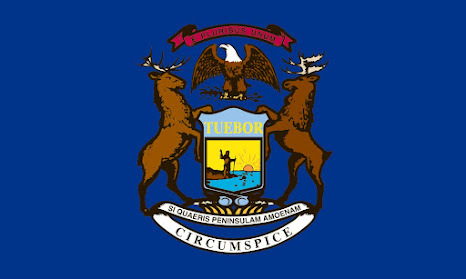Gregory A. Fournier's Blog, page 4
November 11, 2022
Eddie Wingate: Black Detroit's Big Daddy
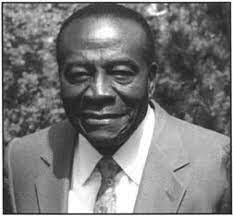 Eddie Wingate
Eddie WingateOne of the economic Titans in Detroit's African American community of the 1950s through the late 1970s was Eddie Wingate. Wingate was born in Moultrie, Georgia, on February 13, 1919, the oldest of six boys. Young Eddie quit school in his adolescence to work on a nearby farm to help support his family on two dollars a day. During the Great Depression, his $10-$12 weekly earnings went a long way, but he had ambition to do better.
Eddie kept hearing the old folks talk about the economic promised land of Detroit where Blacks were making good money working in the auto plants and steel mills. In the late 1930s, Wingate scraped together all the funds he could and drove to Detroit in his rundown Model T to seek his fortune.
At the age of nineteen, Wingate got a job with the Ford Motor Company. It is in the Ford plant that he became acquainted with the illegal numbers racket, called the Policy Racket by government prosecutors. He soon became involved with the business end of the operation.
After almost a decade of working on the assembly line and saving his money, Wingate quit his factory job and became the silent, majority owner of a restaurant named The 20 Grand Supper Club. He was also the sole owner of The 20 Grand Hotel next door where he ran his numbers empire and hosted Detroit's African American cafe society.
By 1961, Eddie Wingate was wealthy enough to pursue his passion for music. Along with his inamorata Joanne Jackson Bratton, they founded Golden World Records (GWR) that made waves in Detroit's pop music scene. Together, they established GWR, Ric-Tic Records, Wingate Records, and J&W Records, Inc. They built their own state of the art studio using the best musical equipment money could buy.
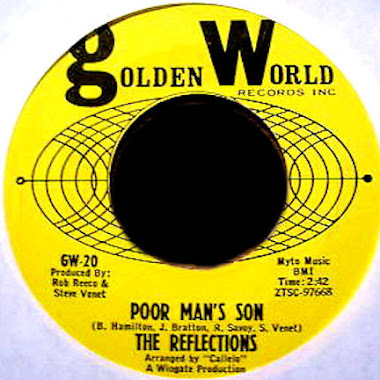
Wingate and Bratton developed their talent roster and used The Driftwood Lounge in the 20 Grand Supper Club, owned on paper by Bill Kabbus and Marty Eisner, as a performance venue for Edwin Starr, The Parliaments, the Manhattans, Laura Lee, and The Funkadelics. The popular venue was a good place to showcase their talent and build an audience to help sell records.
Wingate's personal friend Berry Gordy also used the Driftwood Lounge to break in his growing list of future Motown headliners like The Supremes, Little Stevie Wonder, The Temptations, and The Miracles to gain experience before sending them out on the "chitlin circuit" to hone their performance skills.
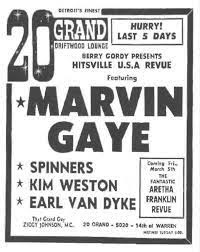
In 1968, Wingate and Bratton sold their record labels, their studio and production facilities, and their artists' contracts to Berry Gordy for one million dollars. Herion and cocaine were flooding the Black community and Wingate's adopted son became a junkie. Disgusted, Wingate turned his back on the hustlers in the music industry. The record business became more trouble than it was worth to him.
The 20 Grand Hotel at 2100 W. Warren Road next to the Supper Club was where Wingate ran his numbers empire from rooms called "The Hole." A Michigan State Police informant testified to a federal grand jury that Wingate's numbers operation included a professional sports book which took bets on football and baseball games ranging from $1,000 to $2,500 over the phone from all over the country . The undercover surveillance occured from June to November of 1976 and relied heavily on wiretapping transcripts.
Early in 1977, the FBI arrested the top operators of the massive inner city bookmaking and numbers running operation. Along with Eddie Wingate, other operators Clarence Williams, John White, Walter Simmons, and Burrell "Junior" Pace were indicted. The men pleaded nolo contendere and paid heavy fines but were never convicted.
The federal government was more interested in the organization's kingpins. In March 1977, a federal grand jury brought indictments against mafioso brothers Anthony and Vito Giacalone for tax evasion. Wingate sold his business interests and left Detroit for Florida. The weather was better there, as were his chances for survival. He left his family operation in the capable hands of his younger brothers.
As a side note, playing the numbers today survives in all fifty states as government run and controlled lotteries used as revenue producing vehicles. Government knew a good thing when it saw it. The odds of winning contemporary govenment lotto games are many thousands or millions of times higher than the classic street game which used only three numbers chosen from 000 to 999, rather than five or six numbers including double digits. It is ironic how laws and attitudes change. What people once went to jail for is now advertised on television and in every convienence and liquor store in the nation.
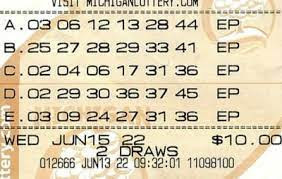 Modern Michigan Lotto Slip
Modern Michigan Lotto SlipWhat is lesser known about Wingate outside of Detroit's Black community is that he and other numbers associates helped many Detroiters buy their first homes despite real estate covenants enshrining racial segregation. Entire White neighborhoods were redlined and off-limits to Blacks who could otherwise afford a conventional mortgage. They were routinely denied mainstream bank loans in desirable Detroit neighborhoods.
Wingate recognized opportunity when he saw it, so he went into the residential real estate business, financed by his gambling profits which were considerable. Authorities would say that he and his associates were loansharking and laundering money, but their clients had steady jobs and most could pay off their monthly mortgage payments on time.
Because of men like Eddie Wingate, Blacks in Detroit had a higher percentage of home ownership in the 1950s and 1960s than any other urban center in the country. To many Detroit residents, Eddie Wingate became a local folk hero despite his underworld activities and connections.
Wingate was sole owner of several commercial buildings which were essentially number and money drops where people from the community were employed as money counters and accountants to keep his game running smoothly. It has been estimated that every dollar spent on the numbers circulated as many as five times in the neighborhoods where the game was played.
Wingate also mentored, influenced, and helped finance many Black entrepreneurs to get started in businesses providing employment and services to city residents. In many respects, Wingate was a rainmaker who brought prosperity to many people enduring hard times.
Eddie Wingate died in Las Vegas on May 5, 2006, at the age of 86. His body was taken back to Detroit for a funeral service at New Bethel Baptist Church on Saturday, May 13th. Wingate's body was interred at Roseland Park Cemetery on Woodward Avenue in Berkley, Michigan.
Mr. Don Davis, chairman of the First Independence Bank in Detroit, wrote in Wingate's online funeral guestbook, "He was the go-to guy (in Detroit) to get anything done of any magnitude if you were Black. The guy held the community together."
November 3, 2022
Ann Arbor High Graduate Becomes Mr. Las Vegas
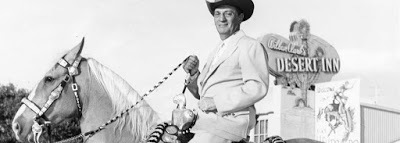 Moe Dalitz in Las Vegas publicity shot.
Moe Dalitz in Las Vegas publicity shot.Morris "Moe" Dalitz was born in Boston but his family moved to Detroit where he grew up in the same Paradise Valley neighborhood with many of the original gang members who became known as the Purple Gang. In his adolescence, Moe's family moved to Ann Arbor where he completed his high school education. During the Purple Gang's dominance controlling Detroit's illegal liquor business, Moe helped his father operate Campus Cleaners, a small chain of cleaners and dyers businesses in the Ann Arbor area. Moe used their fleet of laundry trucks to distribute Purple Gang liquor in Washtenaw County.
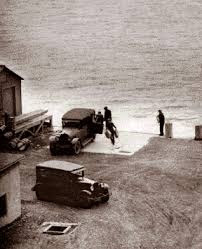 Moe became affiliated with the Little Jewish Navy--a faction of the Purples, that controlled smuggling along the Detroit Riverfront. When three of their top leaders were brutally assassinated by the Purples over an unpaid liquor debt, Moe quietly relocated to Cleveland where he continued his bootlegging operation and opened a chain of mob-protected casinos in Ohio and Kentucky. This became his life's work.
Moe became affiliated with the Little Jewish Navy--a faction of the Purples, that controlled smuggling along the Detroit Riverfront. When three of their top leaders were brutally assassinated by the Purples over an unpaid liquor debt, Moe quietly relocated to Cleveland where he continued his bootlegging operation and opened a chain of mob-protected casinos in Ohio and Kentucky. This became his life's work.Unlike many of his associates who spent their money as soon as they made it buying fancy clothes and flashy cars, Moe maintained a low public profile by investing in legitimate businesses in Michigan. Dalitz held an executive position in the Michigan Industrial Laundry and the Colonial Laundry of Detroit where one of their illegal services was laundering gang money. Moe was also the president of Dalitz Realty Company in Wyandotte, Michigan, that specialized in selling industrial-zoned tracts of land in the Downriver area.
Dalitz served stateside in the United States Army during World War II. While still wearing the uniform, he loaned Detroit Steel $100K to save a collapsing merger with Cleveland's Reliance Steel which proved profitable. In the late 1940s, Dalitz and his underworld backers used Teamsters Union pension funds and began investing in Las Vegas. They lent front man Wilbur Clark--famous Las Vegas developer--the money to build the Desert Inn and then the Stardust casinos.
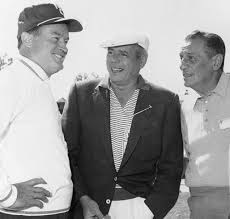 Dalitz with Bob Hope and Desi Arnez.Moe Dalitz became a gaming pioneer and a legend of the Las Vegas Strip. His casinos were one-stop resorts catering to a new demographic changing the face of the Las Vegas Strip--working-class Midwesterners. The Desert Inn and Stardust catered to America's postwar, burgeoning middle class. Dalitz and his investors transformed Vegas from a gambling town to a vacation resort destination. Other organized crime figures took notice and began investing in Vegas opening the door to the Midwest mob's infiltration of Las Vegas, which led to skimming the casinos' gross profits "off the top."
Dalitz with Bob Hope and Desi Arnez.Moe Dalitz became a gaming pioneer and a legend of the Las Vegas Strip. His casinos were one-stop resorts catering to a new demographic changing the face of the Las Vegas Strip--working-class Midwesterners. The Desert Inn and Stardust catered to America's postwar, burgeoning middle class. Dalitz and his investors transformed Vegas from a gambling town to a vacation resort destination. Other organized crime figures took notice and began investing in Vegas opening the door to the Midwest mob's infiltration of Las Vegas, which led to skimming the casinos' gross profits "off the top." Dalitz and other former mob figures discovered a way to sanitize their images. In the early 1950s, they formed the Paradise Development Company which built the Las Vegas Convention Center, Sunrise Hospital, the Boulevard Shopping Mall, a championship golf course, and several buildings at the University of Nevada-Las Vegas. Dalitz became a philanthropic civic leader earning him the name Mr. Las Vegas.
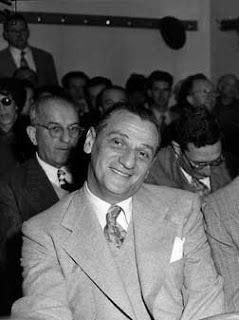 Dalitz at Kefauver crime hearing.Dalitz came from the rough world of the Purple Gang in Detroit and the Mayfield Road Mob in Cleveland. Despite his great success as a businessman and philanthropist in Vegas, Dalitz was never able to completely shed his associations with organized crime figures. He was called to testify before the Estes Kefauver Crime Hearings on February 27, 1951.
Dalitz at Kefauver crime hearing.Dalitz came from the rough world of the Purple Gang in Detroit and the Mayfield Road Mob in Cleveland. Despite his great success as a businessman and philanthropist in Vegas, Dalitz was never able to completely shed his associations with organized crime figures. He was called to testify before the Estes Kefauver Crime Hearings on February 27, 1951.Senator Kefauver asked Dalitz, "We have sworn testimony that you lent Detroit Steel $100,000 for $10,000 worth of company stock. You made $230,000 from that deal, didn't you?"
"Maybe more," was his unapologetic answer. "When I cast bread upon the waters, it comes back cake."
"Mr. Dalitz, didn't you make your original fortune as a rum runner?"
"I didn't inherit any money, that's for sure," Dalitz responded sidestepping the question.
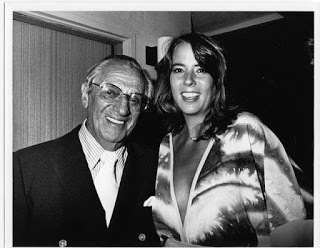 Moe with only daughter Suzanne.Fifteen years later on August 10, 1966, Dalitz was subpoenaed to testify before the Nevada Gaming Commission about the skim and payments to underworld figures. The government was closing in on organized crime organizations who controlled the casinos behind the scenes. The underworld was looking for a way out of the casino business.
Moe with only daughter Suzanne.Fifteen years later on August 10, 1966, Dalitz was subpoenaed to testify before the Nevada Gaming Commission about the skim and payments to underworld figures. The government was closing in on organized crime organizations who controlled the casinos behind the scenes. The underworld was looking for a way out of the casino business.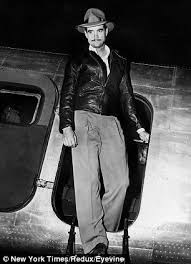 Howard HughesDeliverance came in the guise of Texas billionaire and movie mogul Howard Hughes. Hughes moved from Boston and rented the penthouse of the Desert Inn to live in seclusion as an eccentric hermit. In 1972, Dalitz wanted Hughes out of the suites because the holiday season was approaching and "high rollers"--important to the Desert Inn's bottom line--had annual reservations for those rooms. Hughes didn't gamble. Dalitz had intense negotiations with Hughes over the eviction. Weary of Dalitz's threats, Hughes asked him how much he wanted for the Desert Inn. Dalitz said $13,250,000. Hughes had his chief of Nevada business operations Robert Maheu write out a check and told Dalitz "Get the Hell out of my casino." The penthouse floor became Hughe's private residence while the floor beneath his penthouse suite was used for his business operations. Hughes lived there for four more years until 1976 when he was rushed to Houston, Texas in a Learjet where he died on April 5, 1976. The autopsy listed the cause of Hughes' death as kidney failure.
Howard HughesDeliverance came in the guise of Texas billionaire and movie mogul Howard Hughes. Hughes moved from Boston and rented the penthouse of the Desert Inn to live in seclusion as an eccentric hermit. In 1972, Dalitz wanted Hughes out of the suites because the holiday season was approaching and "high rollers"--important to the Desert Inn's bottom line--had annual reservations for those rooms. Hughes didn't gamble. Dalitz had intense negotiations with Hughes over the eviction. Weary of Dalitz's threats, Hughes asked him how much he wanted for the Desert Inn. Dalitz said $13,250,000. Hughes had his chief of Nevada business operations Robert Maheu write out a check and told Dalitz "Get the Hell out of my casino." The penthouse floor became Hughe's private residence while the floor beneath his penthouse suite was used for his business operations. Hughes lived there for four more years until 1976 when he was rushed to Houston, Texas in a Learjet where he died on April 5, 1976. The autopsy listed the cause of Hughes' death as kidney failure.The Desert Inn sale marked a seismic shift in the ownership of Las Vegas Strip casinos. Corporate interests and billionaire financiers like Kirk Kerkorian were the only entities with the kind of money to buy out the mob. Groups like Bally's, MGM, and Conde Nast ushered in the postmodern corporate era in Vegas that we are familiar with today.
 La Costa Resort and Spa Dalitz and his backers did not get out of the resort business entirely. They moved to San Diego County in 1962 and built the La Costa Resort and Hotel for $4,250,000, which catered to wealthy Americans and aging wise guys looking to escape winter weather back East. On August 31, 1989, Moe Dalitz died in Las Vegas of congestive heart failure and kidney disease at the age of eighty-nine.
La Costa Resort and Spa Dalitz and his backers did not get out of the resort business entirely. They moved to San Diego County in 1962 and built the La Costa Resort and Hotel for $4,250,000, which catered to wealthy Americans and aging wise guys looking to escape winter weather back East. On August 31, 1989, Moe Dalitz died in Las Vegas of congestive heart failure and kidney disease at the age of eighty-nine.Suzanne Dalitz, her Dad, and the Vegas Mob Museum
August 22, 2022
Michigan Native American Treaties--Paradise Lost
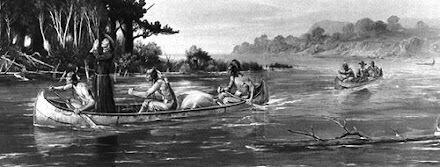 Civilization comes to the Great Lakes?
Civilization comes to the Great Lakes?Thousands of years before the first Europeans set foot in the New World, indigenous tribes were living in migratory groups and large settlements thoughout what became the continental United States. Competition for land and natural resources in America began long before the white man arrived. Great Lakes tribes were feeling pressure from the Iroquios Confederation to the east and the Sioux Nation to the west.
The Ottawa, Chippewa, Wyandot (Huron), and Potawatomi settled near Fort Detroit in the eighteenth century and allied themselves with the French first and then the English as the Great Lakes area became a pawn of international politics leading to an era of intertribal warfare. In 1783, Great Britain ceded the Michigan Territory to the nascent United States.
During the nineteenth century, the Erie Canal opened up the Michigan Territory to settlers with a lust for land. The lucrative fur trade declined due to overtrapping and changing European fashion trends. Michigan pioneers wanted farmland and saw the local Indians as an obstacle, but to legally assume ownership of Indian ancestral land, governmental treaties were formed to relinquish tribal claims to the land.
Tribal leaders received cash, European goods including farming implements, clothing, barrels of whiskey, and empty promises. Once a treaty was signed, duly witnessed, and blessed by the Jesuits, the land was opened to lumbermen, farmers, surveyors, and land speculators from the East. The new American government failed to live up to the terms of its own treaties or its obligations to displaced indigenous peoples.
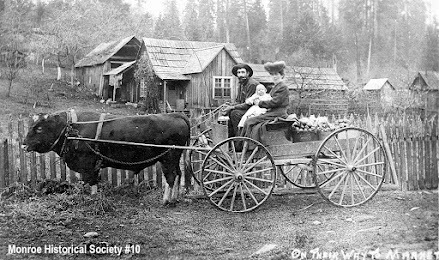 Pioneer farm in Monroe County.
Pioneer farm in Monroe County.Early Michigan settlers preferred the tillable fertile areas in the southern half of the Michigan Territory, but once the North was assayed, mining concerns from the East were interested in copper and iron ore extraction. It was only a matter of time before the government put pressure on Northern Michigan tribes to cede their land holdings.
Michigan Native American Treaties with the United States
*Treaty Name Date Area of Concern
Greenville 1795 The Detroit area north and south along the Detroit River.
Detroit 1807 Much of Southeast Michigan.
Maumee 1817 Most of today’s Hillsdale County.
Saginaw 1819 Alpena-Lansing and areas east.
Sault Ste. Marie 1820 Eastern Chippewa County in U.P.
Chicago I 1821 Southwest equivalent in size to Detroit treaty of 1807.
Carey Mission 1828 Most of today’s Berrian County in the Southwest corner of Michigan.
Chicago II 1833 In today’s Berrian County.
Washington 1836 Western half of northern lower peninsula of Michigan and the upper peninsula east of and including Alger and Delta Counties.
Cedar Point 1836 Today’s Menominee County and part of Delta County.
La Point 1842 The upper peninsula west of Alger County and Delta Country.
* Special thank you to Randall Schaetzl of Michigan State University
August 11, 2022
Norman "Turkey" Stearnes, Mack Park, and the Detroit Stars
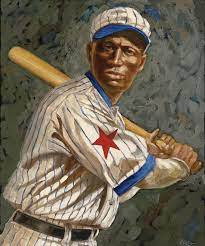 Norman "Turkey" Stearnes
Norman "Turkey" StearnesThe Negro National League (NNL), America's first successful Black baseball league, was the brainchild of Andrew "Rube" Foster, who was born in Calvert, Texas in 1879. He grew up playing sandlot baseball in the Deep South. A gifted pitcher, Foster was a much sought after player for neighborhood and regional teams. He became a vagabond ballplayer and barnstormed throughout the South, scratching out a living on the mound rather than the land. Like many Black Americans, Foster was drawn to the North by the Great Migration for jobs and a better life.
In 1910, Foster had the foresight to realize that the Chicago area, and other Midwestern cities had sizeable Black populations which could support their own city teams. He organized, owned, and managed the Chicago American Giants. The American Giants were a barnstorming team that picked up games whenever and wherever they could, or they hosted exhibitions which allowed local teams and factory teams to compete against a professional team and split the gate profits after expenses were paid out.
Rube, as he became known professionally, also pitched for the American Giants until 1916. At the age of thirty-seven, his weight became a problem, and he lost his snap. Foster decided to hire younger men to take over the hurling chores, so he could devote his full attention to managing and scheduling the team.
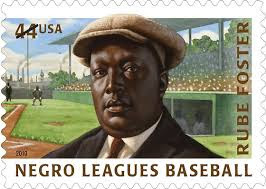 When World War I ended in 1919, Foster acted on his dream to create a professional Negro league modeled after the White major leagues. He installed a new team in Detroit and hired known numbers [illegal lottery] operator John T. "Tenny" Blount to manage the team which Foster dubbed The Detroit Stars. Foster also owned the Dayton Marcos from Dayton, Ohio; he hired someone to manage that team for him also. From these three charter teams, the fledgling NNL was born. Soon four other teams rounded out the league.
When World War I ended in 1919, Foster acted on his dream to create a professional Negro league modeled after the White major leagues. He installed a new team in Detroit and hired known numbers [illegal lottery] operator John T. "Tenny" Blount to manage the team which Foster dubbed The Detroit Stars. Foster also owned the Dayton Marcos from Dayton, Ohio; he hired someone to manage that team for him also. From these three charter teams, the fledgling NNL was born. Soon four other teams rounded out the league.For the next decade, the Detroit Stars played at Mack Park on Fairview and Mack Avenues in the middle of a White, working-class, German neighborhood on Detroit's near Eastside. It was a short four-mile trolley ride from Detroit's Black Bottom neighborhood to the ball park. The Stars performed before mixed crowds and had fans on both sides of the color line.
Mack Park was constructed in 1914 by Joe Roesink, an avid sports fan from Grand Rapids, who ran a successful haberdashery [men's clothing store]. He leased his field to the NNL Detroit Stars, so Detroit could have its own Black team.
On most weekends, as many as 8,000 people could be squeezed into the bleachers with another 2,000 in the grandstand. The ball park was a single-decked structure made of fir lumber planking and tin sheeting over the grandstand. The expensive seats were padded stadium seats under the grandstand. The cheap seats were in the bleachers where spectators had to contend with the elements and teeming crowds. Surprisingly, crowds tended to get along well for the most part.
Mack Park was a left-handed hitters' ball park. Right center field was 279' from home plate, the right field power alley was only 265'. The left field fence was 358', left center field was 390', and center field was 405'. Statistics indicate that NNL batters hit 128% more home runs in Mack Park than in other Negro league park. Soon, the Stars were to have their first superstar who would take full advantage of that.
***
In an aside, on Sunday, July 7, 1929, the Detroit Stars were to play a double-header against the Kansas City Monarchs. Two days of heavy rain had soaked Mack Park. Owner and operator John Roesink wanted to get these two games in before he had to issue rain checks and lose money. The skies cleared and 2,000 fans were inside the ball park anxious to see some good baseball.
Standing water surrounded first and second base. A common practice in those days was to use blazing gasoline to evaporate standing water. [Wouldn't spreading sand be safer and more effective?]
Roesink telephoned a nearby gas station ordering 40 gallons of gas, but the ball park did not have an approved storage tank for that amount, so they filled eight, five-gallon gas cans and stored them under the grandstand along the first base line where the team club houses and the ground keeper's lodging were.
Two gas cans were taken to the infield and emptied on the standing water around first and second base. Before the field was set ablaze, an explosion was heard under the grandstand and someone shouted "FIRE!" Smoke and fire began to rise from the stands and a full-blown panic broke out.
Only four days after the 4th of July, it seems likely someone threw a powerful firework like an M-80 or Cherry Bomb under the stands, but the fire marshal surmised someone dropped a hot cigarette butt under the stands starting the blaze. That theory did not explain the many reports of an explosion and a cloud of black smoke rising before the conflagration. Nobody was ever charged with arson.
Fans were trapped in the stands by a chicken wire barrier to protect them from stray foul balls. Quick-thinking ball players pulled down the wire barrier with some difficulty, allowing fans to pour onto the field, but they were now stuck on the gasoline soaked field. Players from both teams bravely battered down a section of wooden wall enclosing the ball park so fans could escape the flames.
Sixty-one people went to the hospital with thirty cases of broken arms, legs, and other injuries. Miraculously, nobody lost their life. Damage to the park was estimated to be $12,000. Five cars were also lost in the fire. The Stars played out the rest of their season at Dequindre Field at Dequindre and Modern streets on Detroit's far Eastside.
For the 1930 season, Roesink built a new $30,000 ball park for the Stars in Hamtramck, Michigan, located at 3201 Dan Street. Originally named Roesink Stadium, this ball park had a 315' left field fence and a 407' right field fence. Now, right-handed batters had the homerun advantage. Soon, the ball park became known as Hamtramck Stadium.
 2022
2022***
Over the lifetime of The Detroit Stars, many great ballplayers donned the uniform, but one player stood above the rest as the Stars' greatest player. His name was Norman "Turkey" Stearnes from Nashville, Tennessee. The agile and quick Stearnes played first base and pitched for the semipro Southern Negro League in 1920 for the Montgomery Grey Soxs and in 1921 for the Memphis Red Soxs. Scouts from Detroit liked what they saw in the left-handed thrower and batter.
Detroit Stars management offered Stearnes a contract for the 1922 season, but he turned it down so he could finish high school at the age of twenty-one. When his father died, Norman Stearnes had to quit school and get a job to help his mother support their family. But Stearnes returned when he could and graduated late. In 1922, he earned his diploma, much to the joy of his mother. She was determined that Norman get an education.
The achievement is all the more remarkable because in the 1920s, most males and females of both races quit school in the eighth grade when they were fourteen so they could get working papers. Times were always hard and money was to be made.
Stearnes signed with the Detroit Stars for the 1923 season at $200 a month. He soon earned the nickname "Turkey" because of the peculiar way he ran with his arms flapping. But in a foot race, at 5'11" and 175#s, Stearnes was one of the fastest men in the league.
He sported broad shoulders and had a powerful, whiplike swing that could connect with the ball and hit home runs to any field in any park he played in. Remember that in the 1920s and 1930s, baseballs were not as wound tightly and less lively than they are in today's game. When Turkey Stearnes hit a long ball, the leather sphere cried out in pain.
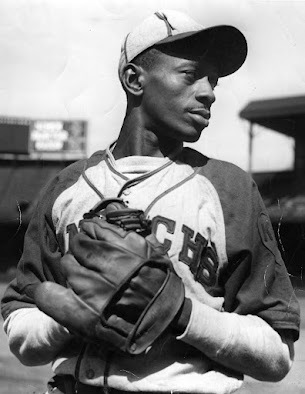 Satchel Paige is considered one of the greatest pitchers of all time in any league.
Satchel Paige is considered one of the greatest pitchers of all time in any league.Turkey Stearnes' upper body strength, quick reflexes, and good batting eye made him a threat at the plate. Legendary hurler for the Kansas City Monarchs Satchel Paige called Turkey Stearnes "one of the greatest hitters in the Negro leagues, as good as anybody who ever played baseball. I feared him more than any other hitter."
The Stars shifted Stearnes to center field where his speed and wide-ranging fielding ability could cover a lot of ground. Most of the real estate in Mack Park was in center field and he owned it.
Turkey Stearnes' career statistics boast a .349 lifetime batting average, 186 league homeruns, 129 stolen bases, 997 runs batted in, and a .617 slugging percentage. Stearnes is the only professional baseball player to lead his league in triples for six years. Five times he was chosen for the Black All-Star Game, twice he was the NNL batting champion, and in 2000, he was elected to Baseball's Hall of Fame sixty years after his career ended and twenty-one years after his death on September 4, 1979, at the age of seventy-eight.
As a player, Turkey Stearnes was detached, colorless, and cooly efficient. Unlike other players, he did not enjoy the spotlight and rarely spoke more than a phrase or a brief sentence. Off the field, he did not smoke, drink, chase women, or keep irregular hours. Stearnes donned the Detroit Stars uniform for eleven seasons. Longer than any other player, and unlike most of the Detroit Star players, he lived in Detroit in the off season with his wife.
In the off season, rather than barnstorm like other players to earn extra money, Stearnes worked in Walter Briggs' automobile body factory at Harper Avenue and Russell Street as a spray painter and a wet sander. He could make steady money that way and spend more time with his wife Nettie Mae.
After working from late autumn through early April, Stearnes left for spring training in 1927, only days before a fire burned down the block-long factory. From then on, Stearnes worked the off-season in the foundry at Henry Ford's Rouge Plant until he retired from baseball and worked there full time.
After Stearnes passed away, his wife Nettie Mae worked to get her husband in the Baseball Hall of Fame, where some of Turkey Stearnes' contemporaries were already installed. She told the Detroit Free Press, "It's not for me or my daughters, it is for Norman. He deserves it."
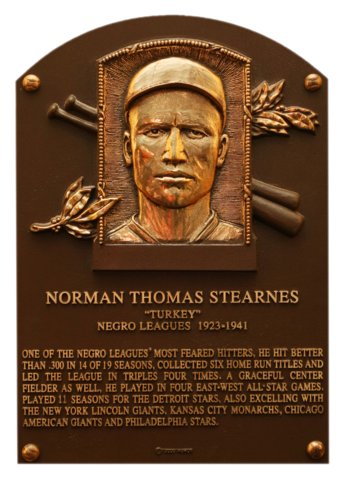 Baseball Hall of Fame Plaque
Baseball Hall of Fame PlaqueWhen the Detroit Tigers moved to Comerica Park in 2000, Norman "Turkey" Stearnes was finally honored with a bronze plaque mounted outside the stadium at the center field gate. Although meant as a tribute to Stearnes by the Tiger management, many Detroit African Americans wondered aloud what it was going to take to get Turkey Stearnes inside the ballpark. There is also a display honoring Stearnes along the third base concourse at The Corner Ballpark, the site of the old Tiger Stadium at Michigan Avenue and Trumbull.
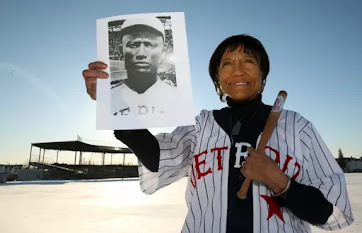 Joyce Stearnes-Thompson at a preservation ceremony for Hamtramck Stadium proudly displaying a photo of her father.
Joyce Stearnes-Thompson at a preservation ceremony for Hamtramck Stadium proudly displaying a photo of her father.Norman "Turkey" Stearnes was elected to Baseball's Hall of Fame in 2000 along with Tiger manager Sparky Anderson. In Comerica Park's center field there is a NNL flag flying commemorating the Negro league. During every Negro League Weekend at Comerica Park, Stearnes' daughters Roslyn Stearnes-Brown and Joyce Stearnes-Thompson sing the National Anthem.
July 11, 2022
Terror In Ypsilanti: John Norman Collins Unmasked--Radio Free Flint Podcast
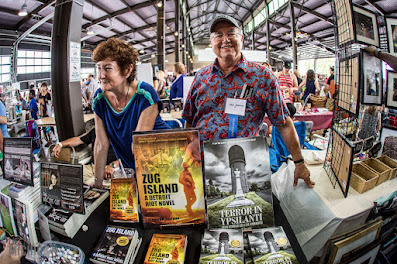 Join us for Detroit Bookfest 5 on Sunday, July 17th, 2022, at the Eastern Market, Shed 5.
Join us for Detroit Bookfest 5 on Sunday, July 17th, 2022, at the Eastern Market, Shed 5.Some months ago, I did an hour long Zoom podcast with Arthur Busch of Radio Free Flint, but there were some technical difficulties in post production.

Art edited a ten minute segment for me, so the interview would not be a total loss. Some of my answers are clipped but can be found within the pages of Terror In Ypsilanti.
June 25, 2022
Detroit Time Capsule Searching for Its Audience
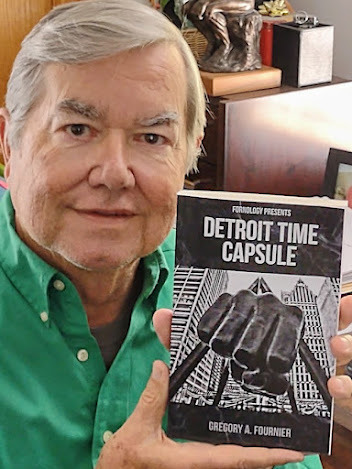
Detroit Time Capsule (DTC) is a collection of 75 of my best Detroit Fornology blog posts gleaned from over 500 posts written over the last decade. DTC tells the story of the city's origin with the arrival of Antoine Cadillac in 1701 to the revitalization of Detroit as one of America's "comeback" cities of the twenty-first century. Each compact entry is three to five pages long for easy, convenient reading.
Published in 2022, this anthology is a trip down memory lane for Baby Boomers in the Greater Detroit area, and an entertaining historical survey for younger Detroiters or recent arrivals to our city of events and people that left their mark on Detroit.
People like Father Gabriel Richard, "Mad" Anthony Wayne, Henry and Edsel Ford, Joe Louis, Berry Gordy, George Pierrot, Mort Neff, Bill Kennedy, Soupy Sales, Edythe Fern Melrose (Lady of Charm), Ollie Fretter, Martha Jean "The Queen," Connie Kalitta, Alex Karras, Leaping Larry Chene, and Shirley Muldowney to name a few.
These posts originally appeared in my Fornology blog but have since been updated and reedited for this edition. As I pull the plug on my blog in the next year or so, this collection will become a collectors' item that includes topics and information you would be hard pressed to find anywhere else. My blog posts will fade into cyberspace, but the book will endure. Makes a great gift for former Detroiter's too.
June 18, 2022
The Elusive Purple Gang--Radio Free Flint Podcast
The Elusive Purple Gang recounts Detroit's violent Prohibition gang and their meteoric rise and fall.
This Radio Free Flint podcast is hosted by former Genesee County [Michigan] prosecutor Arthur Busch. His podcasts are committed to public service and social justice.
 Arthur Busch --Radio Free Flint
Arthur Busch --Radio Free Flint
Busch shares the voices of America's rust belt, their blue collar values, and their way of life. Enjoy my interview with this skillful moderator.
The Purple Gang's Rise and Fall
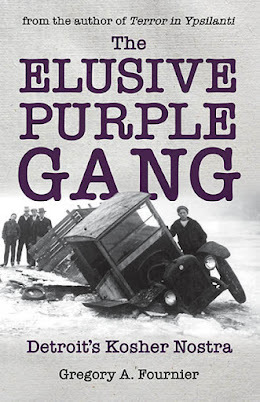
June 12, 2022
Detroit Boxer Joe Louis' Place in American History
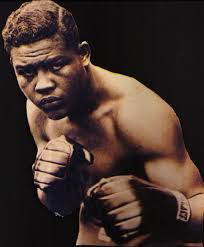
Joseph Louis Barrow was best known as the "Brown Bomber." He boxed from 1934 until 1951 and reigned as heavyweight champion from 1937 to 1949. Joe was born in Chambers County, Alabama--the seventh of eight children. Both of his parents were children of former slaves.
Louis's family moved to Detroit after a brush with the Ku Klux Klan when Joe was twelve. The Louis family was part of the Great Migration after World War I. His family settled on 2700 Catherine Street in the now defunct neighborhood of Black Bottom. When old enough, Joe and his older brother worked at the Rouge Plant for the Ford Motor Company.
During the Great Depression, Joe spent time at a local youth recreation center at 637 Brewster Street in Detroit and made his boxing debut early in 1932 at the age of seventeen. In 1933, Louis won the Detroit-area Golden Gloves Novice Division. In 1934, he won the Chicago Golden Gloves championship and later that year became the United States Amateur Champion in a national AAU tournament in St. Louis, Missouri. By the summer of 1934, Joe had gone pro with a management team.
In 1936, Louis got a title shot versus world heavyweight champion Max Schmeling in Yankee Stadium. The German trained hard while Louis seemed more interested in his golf game--his new hobby. Schmeling knocked Louis out in the 12th round handing Joe his first professional loss. Schmeling became a national hero in Nazi Germany as an example of Aryan superiority.
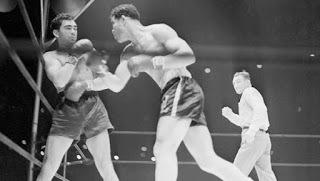 Max Schmeling and Joe Louis rematch.No path to a rematch was open to Louis until June 22, 1938. Louis and Schmeling met for a second time at Yankee Stadium before a crowd of 70,043. The fight was broadcast worldwide in English, German, Spanish, and Portuguese. It should be noted that Max Schmeling was not a Nazi, but the Nazi party propaganda minister Joseph Goebbels hyped the match proclaiming a Black man could not defeat Herr Schmeling.
Max Schmeling and Joe Louis rematch.No path to a rematch was open to Louis until June 22, 1938. Louis and Schmeling met for a second time at Yankee Stadium before a crowd of 70,043. The fight was broadcast worldwide in English, German, Spanish, and Portuguese. It should be noted that Max Schmeling was not a Nazi, but the Nazi party propaganda minister Joseph Goebbels hyped the match proclaiming a Black man could not defeat Herr Schmeling.The American press promoted the match as an epic battle between Nazi ideology and American democratic ideals. Louis became the embodiment of anti-Nazi sentiment. After the big media buildup, the fight lasted only two minutes and four seconds. Schmeling went down three times before his trainer threw in the towel ending the match. For the first time in American history, every Black person and White person in the country celebrated the same event at the same time. Not until the end of World War II would that happen again.
Joe Louis became the first African-American national hero. He reigned as heavyweight champion from 1937 until 1949--longer than anyone else. In 1951, Louis was beaten by Rocky Marciano and retired from the ring. The following year, he was responsible for breaking the color line integrating the game of golf. He appeared as a celebrity golfer under a sponsor's exemption at a PGA event in 1952. How many people know that?
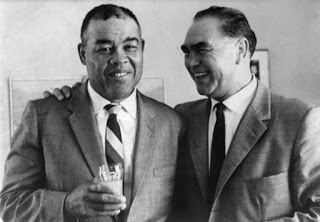 Joe Louis and Max SchmelingJoe Louis died on April 12, 1981 of cardiac arrest at the age of sixty-six in Desert Springs Hospital near Las Vegas after a public appearance at the Larry Holmes-Trevor Berbick heavyweight battle. President Ronald Reagan waived eligibility rules for Joe Louis to be buried at Arlington National Cemetery with full military honors on April 21st. His funeral was paid for by his friend Max Schmeling, who also acted as a pallbearer.
Joe Louis and Max SchmelingJoe Louis died on April 12, 1981 of cardiac arrest at the age of sixty-six in Desert Springs Hospital near Las Vegas after a public appearance at the Larry Holmes-Trevor Berbick heavyweight battle. President Ronald Reagan waived eligibility rules for Joe Louis to be buried at Arlington National Cemetery with full military honors on April 21st. His funeral was paid for by his friend Max Schmeling, who also acted as a pallbearer.In his professional boxing career, Joe Louis won virtually every boxing award there is and was awarded the Congressional Gold Medal posthumously in 1982. The City of Detroit honored Joe Louis with a monument on October 16, 1989. The sculpture was sponsored by Sports Illustrated magazine and the Detroit Institute of Arts. When drivers look left at Woodward Avenue from eastbound Jefferson Avenue (now a No Left Turn), they are confronted with a colossal fist and forearm suspended from a triangular superstructure--a testament to the regard and respect Detroiters hold for their hometown hero.
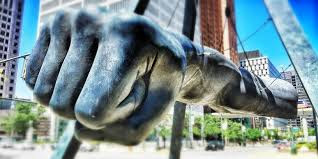
Link to the Joe Louis/Max Schmeling 1937 heavyweight fight
https://www.youtube.com/watch?v=2LNzWHuygpw
June 6, 2022
WXYZ's Fred Wolf and his Wacky Wandering Wigloo
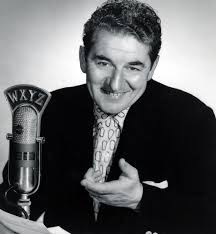 "Master of Sparemonies," the "Old Percolator," "Swampy Joe," and "King of Detroit Morning Radio," Fred Wolf.
"Master of Sparemonies," the "Old Percolator," "Swampy Joe," and "King of Detroit Morning Radio," Fred Wolf.Pioneering Detroit WXYZ sportcaster Fred Wolf was born in Poughkeepsie, New York on May 26, 1910. When Fred was six-years-old, his father died. Fred's mother remarried and the family relocated to Detroit in 1920. The young boy grew up to be a gifted athlete courtesy of the Detroit Recreation Department and their community sports programs.
Fred played baseball when he attended Cass Technical High School and had aspirations to play in the major leagues. As with most high school athletes, that dream never materialized. After high school, Fred studied engineering in a Ford Trade School apprenticeship program.
At the age of twenty, Fred worked as a pinsetter and began to bowl on a league. Within a year, he bowled his first perfect 300 game, he was hooked on bowling and became instrumental in popularizing what was once a pastime into a professional sport.
After Wolf completed his Ford apprentiship, he was hired in 1934 to work in Chrysler Corporation's engineering department. By World War II, he rose through the ranks to become a superintendent at the Chrysler tank plant in Warren, Michigan, where he supervised 450 employees. While at Chrysler, Wolf was captain of the Tank Arsenal team in their company's ten-team bowling league. Other team names were Dodge Main, Super-finishers, and De Soto Engineers, etc.
Fred also bowled on a the Stroh's Keglers team in the industrial league where he was their strongest bowler. On April 29, 1941, he won the individual competition in Detroit's American Bowling Conference out of a field of 32 of the city's top bowlers. He bowled 647 [three game total] while the next best competitor totaled 619. Fred clearly had found his groove.
***
On August 14, 1944, at the age of thirty-four, Wolf hurt his back playing softball which forced him to retire from the semi-professional bowling circuit. He was made manager of the Stroh's Keglers and introduced the bowlers over the public address system and reported scores. Norman White of radio station WJR asked Fred if he ever thought about doing a bowling show on radio. "What would it take?" Fred asked. White answered, "Get a guest, write an interview. Write the whole show--opening and closing--but leave two spots for commercials."
While recuperating from his back injury at home, Fred was listening to the World Series on the radio and wondered outloud to his wife Emily if a bowling tournament could be broadcast the same way. "Why not?" Emily answered.
Fred shopped the idea around to Detroit radio stations before finally being accepted by WXYZ-Radio beginning his long broadcast career. His first weekly show was named The Ten Pin Talker. It was only fifteen minutes long, sponsored by E&B breweries. Wolf reported bowling scores from around Detroit and profiled top bowlers. Broadcasting opened up the bowling and the professional sports world for him.
Radio's The Ten Pin Talker led four years later to television's Make It and Take It, a program where local bowlers would try to make some of bowling's most difficult combinations for cash. Following the success of that program, WXYZ gave Wolf a bowling series called Bowling Champions in 1950. Wolf began live, lane-side broadcasting which became popular locally.
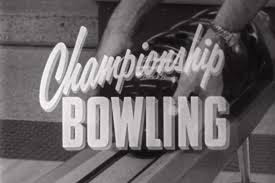 Championship Bowling title card
Championship Bowling title cardIn 1956, the American Broadcasting Company, WXYZ's parent company, asked Wolf if he would like to announce a coast-to-coast program called Championship Bowling for ABC Sports. That program began a twelve-year national run which did much to popularize bowling nationwide and advance the sport.
In the early days of television, bowling was a winter sport, so the WXYZ station manager asked if Wolf could report on something besides bowling. Soon, he was reading baseball scores, announcing boxing and wrestling matches, commentating at golf tournaments, and hosting the popular Hot Rod Races from the Motor City Speedway where midget race cars competed in 25 lap races, and as an added bonus, there was a demolition derby event which Detroiters took an instant liking to.
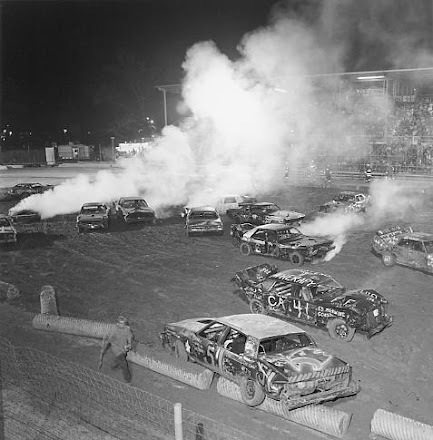 Demolition Derby Carnage
Demolition Derby CarnageWhile Fred Wolf was pioneering television sports programming, he was also a WXYZ-Radio morning deejay beginning in 1950 until 1965. His show was broadcast from 6 until 9 am every weekday morning. WXYZ-Radio originally broadcast from the Mendelssohn Mansion on East Jefferson Avenue.
To gin up interest in his early, music radio program, Wolf asked the station manager if he could have an eight-by-ten foot broadcast booth built three feet off the ground in front of the mansion. He also wanted it to have large windows on three sides so motorists and pedestrians could see him spin records. It was a quirky idea, but the mini radio studio was paid for in radio endorsements for Peterson glass and Chaplow Lumber Company, so the project was given the go-ahead.
Fred christened the booth "Wolf's Wacky Wigloo." It became an overnight sensation drawing in 35% of the morning radio audience. People drove by the Wigloo on their way to work and honked. Wolf told a reporter for the Detroit Free Press, "I like broadcasing from the Wigloo. I can see my listeners drive or walk by. It is more interesting than working in an enclosed studio."
WXYZ had outgrown its downtown studios and urban renewal was about to decimate the Black Bottom area where the studio was located. The station decided to build something they called Broadcast House in Southfield, Michigan. The radio station was slated to move into their new digs in June 1959. Wolf realized he was losing his Wacky Wigloo in the demolition process. On a personal note, he did not want to drive to Southfield from Grosse Pointe Woods. He would have to get up at 3:00 am to make it to work.
As he had done with the original Wigloo, Wolf came up with an original idea. He asked McDonald Trailer Sales if they could modify a thirty-foot trailer and replace the back end with glass on three sides. The station would install the turntables and other broadcasting equipment to make the trailer into a mobile radio studio.
The cost of the trailer would be paid for with radio endorsements. WXYZ management was skeptical but approved the project on the strength of Wolf's popularity and his success bringing in new sponsors and advertising dollars.
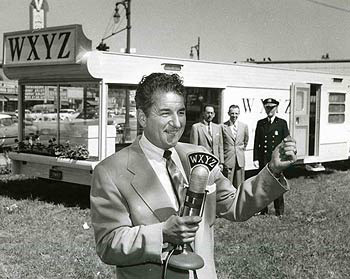 Fred Wolf and his Wandering Wigloo.
Fred Wolf and his Wandering Wigloo.The first stop for the newly rechristened Wandering Wigloo was the University of Detroit campus on the corner of Livernois and McNichols. Wolf pulled up at various familiar locations around town like the State Fair Grounds, City Hall, Detroit Institute of Arts, the Detoit Zoo, and private businesses, especially car dealerships. The Wandering Wigloo would broadcast from businesses for a week if they bought 5 spots a day of targeted advertising for 26 weeks. The Wandering Wigloo soon proved its worth.
The promotion was so successful that radio stations from around the country sent their people to Detroit to witness this public relations innovation. WXYZ soon built a second trailer for deejay Paul Winter, a third trailer was located in Dearborn, and a permanent broadcast booth was installed at the Sears Shopping Center in suburban Lincoln Park. Radio engineers were doing remote broadcasts from 6 am until 10 pm everyday.
Everything was fine until a change of management tightened up their radio broadcasting programming. In short, the dee jays were to talk less, run jingle advertisements, and play music taken from a Top 40 play list. This was the radio industry's response to payola scandals in the music recording and broadcast business in the late 1950s. "Pay for Play" was illegal, and the play lists were the only way radio stations could insure against it. AM radio became repetitive and boring.
Wolf, who was generally a team player, let management know he was displeased. "I play happy music for my morning listeners as they get ready for work. I refuse to play rock & roll." Music trends had changed and his show's ratings dropped.
Wolf decided to retire from his morning radio show in August 1965, but Fred was too valuable to WXYZ to let him go, so he was bumped up to Vice President of Public Relations and official Channel 7 spokesperson. Wolf continued to do special broadcasts like the annual Port Huron to Mackinac Island Gold Cup Races and the Buick Open Golf Tournament.
***
In 1978, a stroke partially paralyzed Wolf and left him unable to speak, though he continued swimming using only one arm. At the age of ninety on August 7, 2000, Fred died in his Grosse Pointe Woods home of complications from a second stroke with his wife Emily by his side. The Wolfs were childless. Fred had a private funeral service and was buried in Roseland Park in Berkley, Michigan.
Emily Rybacki Wolf followed her husband to the grave two years later. At her husband's death, Emily said of him, "Fred was a very upright, kind man and a natural athlete." She must have been a remarkably supportive wife for her ambitious husband who worked long, irregular hours with a punishing broadcast schedule. Whatever they endured together over the years, they were married for sixty-five years.
Fred Wolf produced over 800 local bowling shows on WXYZ radio and television, including 272 hours of announcing nationwide on ABC's Championship Bowling series. Wolf was a championship bowler in his own right and was inducted into the American Bowling Congress Hall of Fame, the Michigan State Bowling Association Hall of Fame, the Greater Detroit Bowling Hall of Fame, and he served as president of the Detroit Sports Broadcasters Association.
A full accounting of Fred Wolf's awards and honors are too numerous to list here, but one stands out in particular. Fred held the American Bowling Congress' record for the most years between his first 300 game and his second in 1975--forty-four years. I am sure that factoid was a source of merriment at Fred's induction to their Hall of Fame. Fred was a bowling champion to be sure, but there have been many bowling champions before and since. Fred was one of a kind.
May 20, 2022
Michigan's Struggle for Statehood
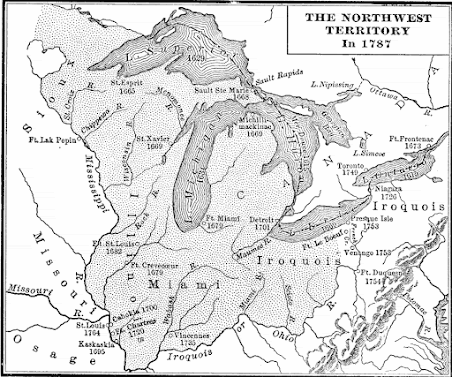
The British officially turned over Fort Detroit to the United States and evacuated on July 11, 1796. At noon, the Union Jack was lowered and the American flag was raised. Michigan was officially part of the United States under control of Territorial Governor Arthur St. Clair. The first United States Federal Census in the Michigan Territory was in 1800. Detroit's numbers were so small that they were lumped in with Wayne County's numbers.
On July 13th, United States Colonel John Hamtramck arrived with 400 soldiers to secure the Detroit command. Detroit consisted of a wharf, a fort, and a citadel of about 100 houses, shops, taverns, and Ste. Anne's Church. Ribbon farms extended on both sides of Detroit from the St. Clair River up stream to the Rouge River downstream. It was estimated that 500 people lived within the stockade with another 2,100 living on nearby farms.
In 1810, the first Michigan Territorial census counted 770 people living in Detroit while the rest of Michigan territory showed a population of 4,762. With a combined population over 5,000, Michigan was entitled to three seats on the Northwest Territory's legislature. By 1815, Detroit was incorporated as the City of Detroit with its own governing board.
Population growth was slow in Michigan because the Surveyor-General of the United States issued a faulty land report based on flawed and incomplete information that the territory was nothing but lakes, swamps, and sandy land. Most settlers hoping to homestead farmland out West opted to follow the Ohio River water highway to Ohio, Kentucky, Indiana, Illinois, and Missouri. The erroneous account delayed Michigan's development.
The inaugural trip of the steamship Walk in the Water, named after a Wyandot tribal chief, left from Buffalo, New York for its destination of Detroit, Michigan in 1818. This marked the beginning of regular steam service carrying passengers and goods between the East and Detroit. Steamship travel on Lake Erie opened up Michigan and the Great Lakes area for farming, timber, and mining interests from New York City.
The 1820 census showed Detroit's population to be 1,442 while Michigan's population grew to 8,927. Government-funded post roads were built radiating from Detroit helping to develop small towns and farming communities inland. On a public safety note, City Fathers erected a public whipping post near the intersection of Woodward and Jefferson avenues to discourage petty crime and drunkeness. It remained in use until 1831. As a result of the Greek War for Independence, 1822 saw a huge influx of Greek immigrants to the Detroit area.
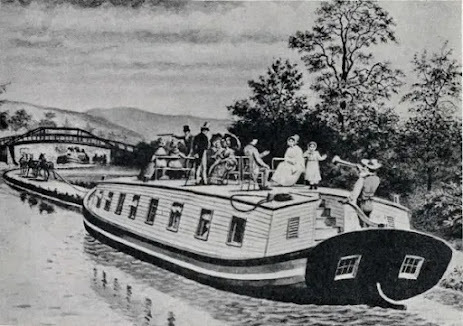 Travelers headed to Buffalo, New York and beyond on a barge boat.
Travelers headed to Buffalo, New York and beyond on a barge boat.The United States' second wave of immigration consisted mostly of Irish and Germans. Many of these newcomers constructed the Erie Canal between 1817 to 1825. The Irish with horses and mules dug 363 miles of canal while German stonemasons engineered bridges and built thirty-six locks that raised freight boats and other canal traffic 565 feet in elevation from east to west. When the canal opened on October 26, 1825, it set off a land boom in Michigan and Detroit until 1837.
The 1830 census of the Michigan Territory counted 85,000 people which qualified Michigan for statehood. There was a delay because of the Toledo Strip dispute with Ohio in 1835. This was the original Buckeye/Wolverine rivalry. The so-called Great Toledo War was a stalemate settled with ink rather than blood.
Michigan was admitted to the Union on the condition that the Ohio boundary be accepted. Ohio got the Toledo Strip and Michigan got the entire Upper Peninsula with some of the most gorgeous and extensive lakefront property in the United States. Statehood was granted in 1837.
Michigan soon adopted its state seal and motto designed by Lewis Cass in 1835. The bald eagle symbolizes the United States, while the elk and the moose holding a shield symbolize Michigan, with the Latin word "Tuebor" meaning "I will defend." The state's motto is "Si Quaeris Peninsulam Amoenam Circumspice" (If you are looking for a beautiful peninsula, look around you), all on a field of dark blue.
